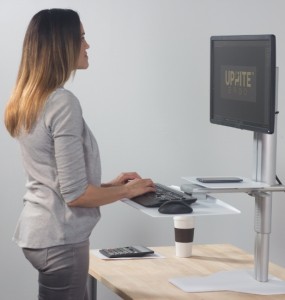
Design Your Work Environment
Improve your workplace wellness! Sitting for long hours folds your body, compressing and weakening your core. Over time your body changes, often taking a big toll on your health.
In addition to back and neck pain, health studies show spending 12 hours a day in a chair increases the risk of developing diabetes by 91% .(1)
Stand up and move around frequently to dramatically reduce the health risks of sitting. Taking micro posture breaks regularly can help. Try StrongPosture® standing once or twice an hour.(2) Using a headset to return calls can allow you to walk as while you talk. And planning a brisk stroll at lunchtime can clear the cobwebs.
If you have to sit, be posture aware, take control and design a smart posture environment.
- Sit strong by stacking your head over shoulders, and your shoulders over pelvis.
- Stacking each PostureZone® engages your core and improves blood flow, digestion, breathing capacity and muscle tone.
- Lift your monitor to eye level, and arrange keyboard so your wrists and forearms are aligned, and shoulders are relaxed.
- Adjust your chair so hips are above the knees.
Tip: Swap your chair for an exercise ball for an hour each day!
Best solution to sitting all day? Don’t.
 Replace your work station with a standing desk to vary your posture during the day. Many businesses begin to recognize the role good body posture and comfort plays in employee productivity. Variable height desks like Sit2Stand by Uprite Ergo let you adjust the height of your keyboard and monitor multiple times throughout the day with the touch of a lever.(4)
Replace your work station with a standing desk to vary your posture during the day. Many businesses begin to recognize the role good body posture and comfort plays in employee productivity. Variable height desks like Sit2Stand by Uprite Ergo let you adjust the height of your keyboard and monitor multiple times throughout the day with the touch of a lever.(4)
Adding 2 to 4 hours of standing and light activity throughout the workday is best, according to the new British Journal of Sports Medicine guidelines.(3)
Alternating between a sitting and standing position will help relieve pain in the back, legs, and neck and other tense muscles caused by stress, strain and overuse.
Tip: A stability disk or foam pad under your work station when standing lets you even keep a foot moving while your typing away. After all, your body Is designed to move (1st Posture Principle).(5)
1. Biswas, A., Oh, P. I., Faulkner, G. E., Bajaj, R. R., Silver, M. A., Mitchell, M. S., & Alter, D. A. (2015). Sedentary time and its association with risk for disease incidence, mortality, and hospitalization in adults: A systematic review and meta-analysis. Annals of Internal Medicine, 162(2), 123-32. doi:10.7326/M14-1651
2. 1st Principle of Posture
3. Buckley, J. P., Hedge, A., Yates, T., Copeland, R. J., Loosemore, M., Hamer, M., . Dunstan, D. W. (2015). The sedentary office: An expert statement on the growing case for change towards better health and productivity. British Journal of Sports Medicine, 49(21), 1357-1362. doi:10.1136/bjsports-2015-094618
4. Uprite Ergo office ergonomics.
5. Stand Taller Live Longer, An Anti- Aging Strategy, S Weiniger, BodyZone Press, 2008
